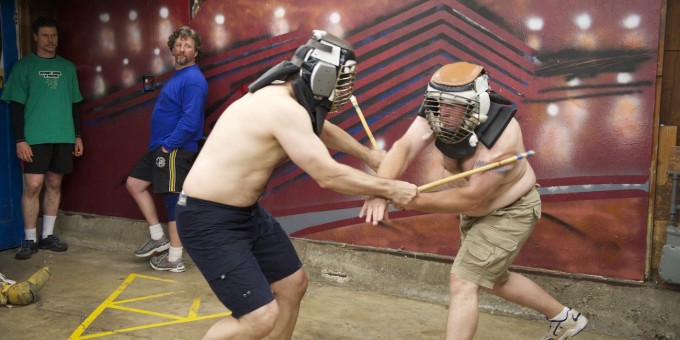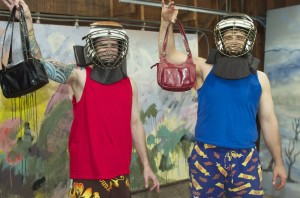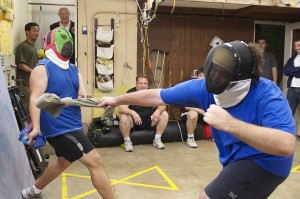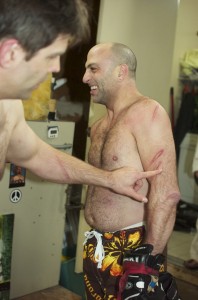
Photo by Mei-Yan Chiang
Ritual Violence in a Two-Car Garage
KICK ASS AND TAKE NAMES!
You were **BORN** for violence my fellow MAN.
Take up that stick knowing in your heart of hearts that every fiber of your being has either evolved through fighting and death or was simply created
…to do…
THIS.— e-mail from Fight Club member two days before my first fight
“Do not cripple your friends. Do not bring them to tears,” says the organizer.
“If it’s your first time at Fight Club,” he adds, turning to face me, “you fight first.” He hands me a dulled, rounded 9-inch training knife, padded gloves, and a fencing mask. My opponent, Mike, is about the same size as me. He has a knife, too. Unfortunately for me, Mike actually knows how to use his. I have no fight training or experience, and it’s about to be painfully evident.
I try not to think about the language in the release form I just signed. “I the participant, am knowingly risking injury, which typically includes bruises, bumps and scrapes but can include serious injury and death from either fighting or watching.” Bruises. Bumps. Scrapes. Death? It’s unlikely anybody will come close to dying today—at least not of anything more than humiliation.
Mike and I are fighting under the auspices of The Gentlemen’s Fighting Club—a San Francisco Bay Area group formed in the late 1990s. In GFC’s history, there have been few serious injuries. This fact, along with the thickly padded gloves and sturdy mask, alleviate most of my concerns. Still, I am tempted to repeat the pre-fight instructions to Mike: Please do not cripple me or bring me to tears. “Fighters ready?” the timekeeper asks. I tighten my fingers around the handle of the training knife and square off with my opponent. “Fight!”

Almost all the men have a martial arts or fighting background. None are amateur or professional mixed martial arts (MMA) fighters. Sanctioned, refereed MMA fights are short, violent exchanges that typically end with a knockout or forced submission. GFC provides a more authentic combat experience than martial arts sparring and less risk of injury than MMA, as well as an especially varied and creative array of weapons. In addition to the grappling and hitting that is part of martial arts and MMA, these fighters use brass rods rolled-up into magazines, unopened soda cans or soap bars wrapped in pillowcases, small purses filled with buckshot, folding chairs, cookie sheets, computer keyboards, and even metal chains.
Fighters wear just about any protective gear they choose, or none at all. Bruises, cuts, blood, and pain are routine. Broken fingers happen. The stakes are higher than a schoolyard fight, but only rarely does someone get badly injured. They have to go home to their families and to work the next day, and they want their friends and foes to leave intact, so they can return to fight another day.
Geek Fight Club?
They’re crazy! It’s fake! A Geek Fight Club!? More like cubicle jockeys desperate to feel something real.
When the media first discovered the Gentlemen’s Fight Club, reporters, fighters, martial artists, academics, and others joined in laughter, scorn, and skepticism. What motivated these guys to take up arms and fight? To answer that question, I observed fights, participated in one afternoon of combat, and interviewed 13 GFC fighters on their own and three in a group setting. I found that these men fight to test their skills and toughness, to conquer their fears, and, in some cases, to restore a sense of masculinity and control they lost during experiences of boyhood emasculation.
GFC is a democratic institution. Occupation and social class aren’t used as filters for entry. Although members joke about excluding “yuppie punchers’’ and the “Gentlemen” moniker harkens to upper-class British pugilists, no interested fighter has been turned away. Landscapers, marketers, police officers, community organizers, students, and even a couple self-identified gang members have fought at GFC. Social class and status disappear behind the headgear and weapons.

The fighters I chose to interview are a racially and ethnically diverse group in their 20s, 30s and 40s, single or with children, and mostly college-educated. Like most GFC regulars or visitors, they are unlikely to find themselves fighting in a bar or anywhere other than GFC. Of course, each fighter brings a different biography and life experience to the club. But they share a similar cultural upbringing: longtime American attitudes towards men’s violence and combat that transcend divisions of class and race.
Boys to Men
American culture simultaneously expects, celebrates, and punishes violence in boys and men. Despite the contradictions, and without a formal rite of passage from boyhood to manhood as found in cultures throughout the world, our society produces the unofficial, nearly universal boyhood ritual of fighting. American educators, parents, and law-enforcement authorities have been trying to discourage fighting, violence, and bullying, now broadly defined to include physical and verbal intimidation.
But real-life fighting continues to be the way most boys prove themselves physically, testing themselves and one another. For some men, GFC is simply an extension of their lifelong fascination with fighting—from vicariously experienced cartoon violence to actual schoolyard clashes and martial arts training. Another inspiration for the GFC was the rise of mixed martial arts, in which fighters use all disciplines; the first Ultimate Fighting Championship was held in 1993.
It‘s unclear how many fight clubs exist. There are, of course, media stories about teenagers fighting in front of crowds of fellow teenage spectators. These fights may be staged for fun, for gambling, and sometimes to create homemade movies that are sold for profit. They have little in common, though, with the handful of adult fight clubs I discovered during my research. With the exception of GFC, the adult clubs were either no longer active or deeply underground, and they mostly mirror increasingly popular and mainstreamed mixed martial arts (MMA) events.
Gentlemen’s Fight Club is the only club I located that uses weapons and holds regular fight nights. It is distinct from MMA and other groups in one other significant way: winning and losing is irrelevant. No one scores the fights or keeps track of the number of strikes landed. There’s almost a team spirit, despite the one-on-one nature of combat. The fighters have an interest in helping each other build their skills, but they show no interest in ranking each other, playing out anger, or humiliating anyone. The fighters certainly deliver painful blows and cause injuries to opponents, but there’s no intent to cause serious harm.
In one of my fights, my stronger opponent skillfully delivered painful strikes using rattan sticks, but he didn’t bull-rush or grab me, pin me down, or pummel me. Stronger and more skilled fighters use the weapons to expand their own and their opponent’s skills. They gain nothing by overwhelming smaller, less experienced fighters with brute strength. Winning is supplanted by skill development.
A couple of GFC fighters eagerly spoke of physically dominating their opponents, using aggression and overwhelming force. But as sociologist Michael Kimmel argues in his 2006 book Manhood in America, being a man isn’t really about pursuing domination over others—it’s about evoking a fear of being dominated and controlled. For many GFC fighters, it’s gratifying just to participate, to put oneself at risk and survive, to experiment with losing and establishing control. All this is to say, asserting masculinity isn’t necessarily about inflicting damage. It’s about controlling others, and controlling one’s own reactions and emotions—especially fear.
Losing Control
Many men are motivated to fight because they’ve arrived at adulthood without evidence (at least for themselves) that they’ve passed the “test.” They want to know if their own strength and training would hold up in a real fight, if they have the courage to face an armed attacker. Can they overcome a sometimes paralyzing fear of injury and protect themselves and their families—maybe even kick a little ass if they have to?

Asher is 34, married, and a father. He has a lucrative career in the technology sector. Like several of the men I met, he was bullied and beaten up as a boy and considers those experiences formative: “I felt like a weakling most of my life.” Asher’s father enrolled him in martial arts classes, but he quickly quit and has long regretted not being better at “standing up for myself when I was younger.”
GFC fighter Sammy, 44, spent years training in martial arts and sparring in dojos, but when he heard about GFC he was still asking himself, “Can I really fight?” He is slight of stature, which, not surprisingly, exposed him to more bullying as a child and teen in the occasionally violent and gang-ridden neighborhoods where he grew up. When threatened by gang members, he said, all of his options felt emasculating: crying for help, submitting by begging for mercy, or suffering the pain and failure of being beaten. He chose submission to avoid the physical pain. “Saying ‘Sorry, sorry,’ many times definitely hurts your ego,” he told me, laughing ruefully. It was “powerful, because I was all cocky when I was young and then, ‘Oh, fuck. A few guys come [at] you and then you’re nobody. Definitely, this had something to do with getting me to try to practice [martial arts] and prove my manhood.”
Freddy, one of the long-time GFC regulars, says he got into grappling and wrestling to get the feeling that he could control his own body and others’. Once, when he was in elementary school, two older neighbors pinned him down, stripped him of his clothes, and ran away, leaving him to try to sneak back into the house, naked, in front of some older women relatives. He’d not only lost control of his body, but was exposed, literally and figuratively. When he was in college, some “friends” tried to pull a similar stunt, grabbing him and attempting to strip him naked in a dorm hallway. This time, he says, “I kneed the first guy in the balls; I turned around and grabbed the other guy by the throat and threw him down.”
Fight Therapy
For these men, Fight Club offers an opportunity to replace the psychological scars of bullying and submission with physical scars they can wear as trophies of manhood. Fighting is therapeutic, and it brings more than understanding. The fighters can confront their feelings of failure directly, as adults. And they restore a sense of control, paradoxically, by choosing to give it up, placing themselves at risk. Even when they lose, by demonstrating an ability to withstand violence, they are reestablishing their masculinity. A fight is a “situation where you just don’t know what’s going to happen,’’ says Asher, “but now, I know what I can do and I know that I’m not going to lose my cool.” It’s not about eliminating fear, he says, “but knowing you’re not a coward.”
“After I got punched enough times [at Fight Club],” Sammy says, “I understand that I can definitely take a [big] punch and then I’ll nail you one.” Sammy doesn’t expect to be bullied by gang members now that he’s an adult, but if he finds himself in that situation, he now has the confidence to deal with it. He expected to reclaim his manhood by beating up his Fight Club opponents. Instead he came to believe that the “true power” was being able to withstand a beating. Getting hit is, in many ways, more important than hitting.
“So, sometimes losing is winning?” I asked him. “Losing is definitely winning,” he said. He now invites and even embraces fights with men at GFC who are stronger and may subject him to countless strikes. The same confidence has helped him handle non-violent confrontations at work, he notes.
Freddy’s extensive GFC experience has translated to an acute self-awareness and sense of control. “Now I think of myself as a hard target. I don’t feel like a mark,” he says. “Only I kill me.” With the skills and confidence he has developed, he believes it’s only his own mistakes that lead him to lose a fight.
Ronnie, another experienced martial artist, says he wanted definitive proof that fear could no longer dominate him. “What I get [from fighting at GFC] is the truth. [To know] that I could protect myself and I’m not scared in any situation.’’ He wavers a little. “[Well] you get scared in a lot of different situations. But I feel, well, it gives me a level of confidence.”
Social science research reveals that men who fall short on some measure of manhood often find other outlets to compensate for their perceived shortcomings. Young men living in poverty and denied access to good jobs may assert themselves through sports, sexual conquests, or risk-taking activities like crime. Adult men who fail as breadwinners are more likely to abuse their wives or girlfriends. Men with physical disabilities may highlight their decision-making skills and authority to offset their inability to live up to men’s body ideals.
GFC offers at least one group of men a direct way to repair and bolster their masculine identities. This may help explain why they don’t reject cultural expectations of physical toughness and control or embrace a different definition of manhood.
In place of recurrent memories of humiliation, some GFC fighters say they have daily fantasies or daydreams in which they are superheroes or doing heroic things. Some confess to harboring fantasies of violence—such as clearing a bar full of people when forced to defend themselves. Even after proving their courage, toughness, and ability repeatedly at GFC, some fighters return again and again, for months or even years. The ritual binds them.
New fighters may feel as if they are undergoing a controlled hazing ritual, but the regulars help create the best of a fraternal atmosphere—camaraderie and bonding—without fear of being judged by other men. The bond is evident in the post-fight hug, an authentic embrace of appreciation and respect. My afternoon of fighting ended, as they all do, with beer and laughter while watching recordings of the fights. (No copies of the videos are made or distributed.)
GFC may be unique in the way it cultivates the most visceral element of American manhood. Unlike MMA competitors, these garage fighters don’t attempt to injure each other to win. And unlike middle school bullies, they don’t try to physically humiliate each other. They push and challenge each other, encouraging everyone to grow as fighters—and as people. As one veteran explained as I prepared for my first fight, your fellow fighters are “there to bring you up, not beat you down.”
Masculinity is elusive and tenuous, always capable of being undermined by a single failure. GFC gives men a venue where they can prove themselves physically, shielding them from the burden of trying to dominate others—and the fear of being dominated.
Recommended Resources
Canada, Geoffrey. Fist Stick Knife Gun: A Personal History of Violence in America (Beacon Press, 1995). Describes boys’ street socialization, unwritten rules about and informal training in fighting, and violence in tough, inner-city neighborhoods, before and after guns were prevalent.
Kimmel, Michael. Manhood in America: A Cultural History, 2nd Edition (Oxford University Press, 2006). Exhaustively documents and analyzes culturally ascendant and competing versions of American manhood throughout U.S. history.
Messerschmidt, James W. Nine Lives: Adolescent Masculinities, The Body and Violence (Westview Press, 1999). Examines young boys who have been physically and sexually abused, and who have attempted to overcome their victimization by committing these acts against peers.
Phillips, Debby. “Punking and Bullying: Strategies in Middle School, High School, and Beyond,” Journal of Interpersonal Violence (2007), 22(2):158-178. Explains how boys use verbal and physical abuse to humiliate and shame other boys in an attempt to demonstrate their own masculinity.

Comments 1
Paul Vogt
September 25, 2013Very interesting article. It would have been interesting to learn a bit more about Melzer's thoughts on methodology, such as the the role of participant observation (auto-ethnography?) in drawing conclusions in this study.